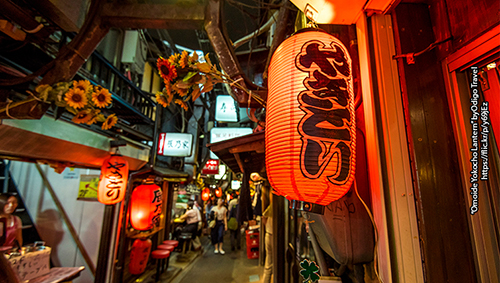英語記事に慣れる「サクっと読む英文」
2017.6.13
Yokocho
Read the article to find out where some popular yokocho are located in Tokyo.
東京にある人気の横丁について、記事を読んでみましょう。

“Yokocho” means “narrow alleys off the main street”; they are known as areas where you can find many small izakaya (Japanese pubs) and yakitori (grilled chicken skewers) and ramen shops.
The history of yokocho starts in the middle of the 20th century. In Shinjuku’s Omoide Yokocho there were stalls that sold clothes, shoes, soap, and other everyday products. In the post-war period, the government did not give people enough food. It was difficult for people to get flour and other goods to make noodles. People in yokocho started businesses using goods and ingredients that were available. These ingredients were often low quality, like offal. As time went on, the area started to bring in chicken and sushi. In the 1990s a fire burned many of the buildings in the alley. Today, there are over 80 stores in Omoide Yokocho that serve oden (winter stew), yakitori, horumon (pork or beef offal), and alcohol in a traditional style.
These days, you can find yokocho all over the Tokyo area. Here are some famous yokocho:
HARMONICA Yokocho – Kichijoji
In front of Kichijoji Station, there is an alley with many small shops. It is called Harmonica Yokocho because of the way the many shops are lined up, like the holes in a harmonica. The area has a long history that goes back to the post-war period. It started as an underground market. However, the alley still brings in many young customers. New stores have been opened since the late 90s.
NONBEI Yokocho – Shibuya
These alleys date back to 1950 (the 25th year of the Showa period) and there are many shops where you can enjoy oden and yakitori. Some of these stores have been popular since the time following World War II. Regulars include Japanese customers of various generations, performers, foreigners, and young women.
GOLDEN GAI – Shinjuku
This popular yokocho is a small neighborhood of alleys, a short walk from Shinjuku station. There are more than two hundred small bars and pubs in this area. This district is famous for the celebrities and cultural figures who got together, drank, and had discussions in a variety of themed bars (e.g. anime themed or rock themed). These days, more than half of the customers in this area are foreigners. If you enjoy lively drinking spots, this is the perfect place for you.
OMOIDE Yokocho – Shinjuku
Along with GOLDEN GAI Yokocho, this is one of the two big yokocho in Shinjuku. In this area, there are many old-style izakaya. Even today, you can still enjoy grilled chicken and offal. The shops in this yokocho bring in people of all generations.
Yokocho are great places to get to know Japan. Yokocho can show you a completely different side of Japanese cities. Next time you have a friend visiting from overseas, why not take them to a yokocho?
Large cities in Japan have many smaller streets called yokocho. In these yokocho there are red paper lanterns, smoky stores, and noisy people enjoying food and drinks in small rustic restaurants. In the evening you can find office workers, young people, and older customers relaxing in these bars and shops.
“Yokocho” means “alleys off the main street”. They are areas where you can find many small izakaya (Japanese bars) and yakitori (grilled chicken skewers) and ramen shops.
Yokocho started in the middle of the 20th century. In Shinjuku’s Omoide Yokocho there were stores that sold clothes, shoes, and other everyday products. In the post-war period, the government did not give people enough food. It was difficult for people to find goods to make noodles. People in yokocho started businesses using food that was available. They used cheap and low quality goods like offal. As time passed, the area started to bring in chicken and sushi. In the 1990s a fire burned many of the buildings. Today, there are over 80 stores in Omoide Yokocho that serve oden (winter stew), yakitori, horumon (pork or beef offal), and alcohol.
These days, you can find yokocho all over the Tokyo area. Here are some famous yokocho:
HARMONICA Yokocho – Kichijoji
In front of Kichijoji Station, there is a yokocho with many small shops. The name comes from the way the shops are lined up. The area has a long history that starts in the post-war period. However, many young customers still go there. New stores have opened since the late 90s.
NONBEI Yokocho – Shibuya
These alleys started in 1950 (the 25th year of the Showa period) and there are many shops where you can enjoy oden and yakitori. Some of these stores have been popular since after World War II. Regulars are Japanese customers of all ages, artists, foreigners, and young women.
GOLDEN GAI – Shinjuku
This popular yokocho is a group of alleys a short walk from Shinjuku station. There are more than two hundred shops and bars in this area. Golden Gai is famous because in the past many people went to bars with a special theme (e.g. anime or rock). These days, more than half of the customers in this area are foreigners. If you enjoy fun drinking areas, this is the perfect place for you.
OMOIDE Yokocho – Shinjuku
Along with GOLDEN GAI Yokocho, this is one of the two big yokocho in Shinjuku. In this area, there are many old izakaya. Today, you can still enjoy grilled chicken and offal. People of all ages visit the shops in this yokocho.
Yokocho are great places to get to know Japan. Yokocho can show you a very different side of Japanese cities. Next time you have a friend visiting, why not take them to a yokocho?
キーフレーズ
red paper lantern 赤ちょうちん
lively local 活発(陽気)な地元住人
rustic 質素な、ひなびた
alley 路地
stall 露店
post-war period 戦後
offal 臓物(ホルモン)
as time went on 時が経つにつれて
▼こちらもCheck!
使いこなす句動詞 “go on”
regular 常連客
“regular” には常連客という意味もあり、飲食店や興行場などにいつも来る客のことを表します。
例:He was a regular at my coffee shop for years.
(彼は何年も私の喫茶店の常連だった。)
lively drinking spot 活気のある酒場
bring in ~ ~を呼び寄せる、もたらす
人を連れてくる、呼び寄せる、または利益などをもたらすという意味です。通常、顧客について話すときに使われることが多い表現です。
例:Our new ad campaign has been bringing in a lot of new sales.
(新しい広告キャンペーンは多くの新規販売を呼び寄せている。)
get to know ~ ~を知るようになる、知り合う
ある人や事柄について知るようになる、理解するようになるという意味の表現です。
例:I got to know her when we shared a dorm room in college.
(大学の寮で同じ部屋になってから彼女のことを知るようになった。)
“get to know” は、ある人や事柄について知ったり親しくなった「経緯」を示しています。一方 “know” はその経緯の「結果」(知る)を意味します。
why not ~? 〜したらどうですか?/ぜひ・もちろん
“why not” は主に、以下の2つの意味で使われます。
(1)提案やアドバイスをする
例:Why not leave a bit earlier so you don’t have to rush?
(急がなくて済むように、もう少し早く出かけたらどうですか?)
(2)人からの提案や誘いに同意する
例:
- A:
- Do you want to go out for lunch later?
- B:
- Sure, why not?
- A:
- 後でランチを食べに外に行かない?
- B:
- いいね、行こう。


 【Gabaからのお知らせ】
【Gabaからのお知らせ】 【特集】
【特集】 【英単語の正しい使い分け】
【英単語の正しい使い分け】 【使いこなす句動詞】
【使いこなす句動詞】